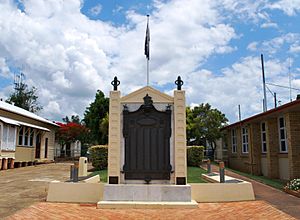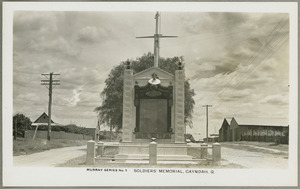Gayndah War Memorial facts for kids
Quick facts for kids Gayndah War Memorial |
|
|---|---|

Gayndah War Memorial, 2008
|
|
| Location | Capper Street, Gayndah, North Burnett Region, Queensland, Australia |
| Design period | 1919 - 1930s (interwar period) |
| Built | 1921 - 1995 |
| Architect | Ernest Gunderson |
| Official name: Gayndah War Memorial, Rawbelle Shire War Memorial | |
| Type | state heritage (built) |
| Designated | 21 October 1992 |
| Reference no. | 600517 |
| Significant period | 1921-(social) 1921(historical, fabric) |
| Significant components | war trophy/ies, memorial - honour board/ roll of honour, memorial - other |
| Builders | Ernest Gunderson |
| Lua error in Module:Location_map at line 420: attempt to index field 'wikibase' (a nil value). | |
The Gayndah War Memorial is a special monument found on Capper Street in Gayndah, Queensland, Australia. It was created in 1921 by Ernest Gunderson. This memorial is also known as the Rawbelle Shire War Memorial. It was added to the Queensland Heritage Register on October 21, 1992. This means it's an important historical site.
Remembering World War I
The Gayndah War Memorial was built to honor the soldiers from the local area. It specifically remembers those who served in World War I. This includes the 270 men from the Rawbelle Shire and Gayndah Town who fought. It also honors those who sadly lost their lives.
This memorial was a gift from Harold Wilson. He lived at a nearby place called Cooranga station. He paid for the memorial himself. Then, he donated it to the local councils. The memorial was officially revealed on September 8, 1919. Mr. Bernard Corser M.L.A. did the unveiling.
Why War Memorials Are Important
Before World War I, Australia didn't have many public monuments. But after the war, memorials became very common. They showed how much the war affected the young country. Australia lost about 60,000 people. This was out of a population of only 4 million. About one in five of those who served died. No other war has had such a big impact on Australia.
Even before the war ended, people started building memorials. They were a way to show national sadness. For many, these memorials were like graves. They were a place to remember soldiers whose bodies were buried overseas. British rules said that soldiers should be buried where they fell. The word "cenotaph" means "empty tomb." This was often used for war memorials.
Australian war memorials are special because they don't just remember the dead. Australians were proud that their army was made of volunteers. These men were honored whether they died or not. Many memorials list all who served from an area. This helps us learn about how communities were involved in the war.
Art and Design of Memorials
Australian war memorials also show us about loyalty to the British Empire and Australia. They show the skills of local artists and builders. In Queensland, statues of a "digger (soldier)" (an Australian soldier) were popular. In southern states, tall, pillar-like "obelisks" were more common. This might be because Queensland had more working-class people. Also, fewer architects were involved in designing memorials there.
Many World War I memorials have been updated. They now include names from later wars. Some have been moved or repaired in ways that weren't always good.
The Gayndah Memorial's Unique Features
Most honor boards are inside buildings, like a town hall. But the main honor board at Gayndah is outside. It's in a public space between the Post Office and the Library. Ernest Gunderson created this board. People think it's his best work. Gunderson himself felt it was his finest piece.
Ernest Gunderson started his metalworking company in Brisbane. He came from Norway. His company made honor boards for all over Queensland until the mid-1930s. Gunderson designed the art himself. Then, it was added to a dark brass frame. The Gayndah board has a mix of Australian and British symbols. It also has many other special emblems. Gunderson often used things like old artillery shells in his work.
Changes Over Time
In the 1960s, some changes were made to the memorial. The original brass letters were replaced with new nameplates. These old parts are still kept in storage. Other small changes were also made then.
In 1995, more repairs and additions happened. This was for the 50th anniversary of the end of the Pacific War. A lost statue of "Liberty" was remade in bronze. Brisbane artist Fred Waitehouse used old photos to recreate it. Bronze figures of horsemen were also added. These were copied from another Gunderson memorial in Petrie.
A Krupp gun from 1903 was also repaired. This was a "war trophy" (a captured enemy weapon). It was given new wheels and armor. It was set up facing the street. A small garden was built around it. Concrete slabs were added nearby. These remember people from the area who served in World War II and later wars, up to Somalia.
"Sam" Weller from the local RSL helped with the 1995 work. Frank Robinson and his family paid for the costs. The original World War I Memorial used to have a fence and a light. These were removed, possibly for the 1995 additions. The original flag pole was also replaced.
What the Memorial Looks Like
The World War I Memorial is located between the Post Office and the Library. It faces Capper Street in Gayndah. Behind it is a memorial garden. This garden has the trophy gun, paved areas, and flower beds. Concrete slabs around the garden remember service members from World War II and later conflicts. The names from World War II are carved into white granite. Other plaques are made of bronze.
The World War I Memorial is made of concrete and bronze. It has a bronze honor board. This board is placed on a concrete structure that stands freely.
The concrete structure sits on a wide, stepped base. The top step has a marble-like finish in the middle. The structure itself has a flat central part. It has a triangular top, called a pediment. On each side are two square pillars. These pillars have a simple pattern on their front. On top of each pillar are artillery shells with bronze wreaths around them. At the bottom of each pillar are bronze plaques. These remember later wars.
The bronze honor board is on the central part. It lists the names of local men who served in World War I. Those who died have a small crown next to their name. The names are in five columns in the middle of the board. A clear glass cover protects them.
The top of the board has decorative scrollwork. In the middle is a female figure of Britannia. She holds a shield that says "Liberty." Below her is a laurel wreath around crossed flags. The words "FOR KING AND COUNTRY" are also there. A small oval plaque tells about the memorial's origins. It is flanked by AIF badges. The words "ROLL OF HONOUR" follow the scrollwork. On each side of this central section are decorative pillars, called pilasters. On top of these are figures of mounted Light Horsemen. Below them are the dates 1914 - 1919. At the bottom of each pilaster are carvings of infantry soldiers.
The bottom part of the board has oval plaques in each corner. These show carvings of an emu and a kangaroo. In the center, there are more carvings of a British lion and a kangaroo. Cannons are shown on each side.
Why It's a Heritage Site
The Gayndah War Memorial was added to the Queensland Heritage Register on October 21, 1992. It met several important requirements.
Showing Queensland's History
War memorials help us understand Queensland's history. They show a common trend where most communities across the state were involved. They prove a time of strong Australian pride and national feeling. This was especially true during and after World War I.
A Unique Cultural Site
This memorial is special because it was paid for by a private person. Then, it was given as a public memorial. Later, another big private donation helped improve it. This makes it a rare example of its kind.
Key Features of a Memorial
These monuments are important records. They show what was popular in art and design between the two World Wars. The Gayndah memorial was built in 1921. It shows the main features of a monument built to remember a major historical event. It uses suitable materials and design elements to do this.
Its Beautiful Design
The memorial and its setting are very beautiful. They show high-quality work and design. They also add to the beauty of the town.
Important to the Community
The memorial has a strong and ongoing connection with the community. It shows the impact of a major historical event. It is also a central place for people to remember that event.
Connected to Important People
It also has a special link to the metal worker Ernest Gunderson. It is considered the best example of his work in Queensland.


